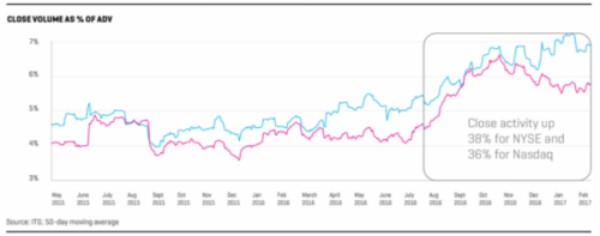The increasing popularity of passive and indexed investments has affected a change in volume profiles for the U.S. equity market. As more money flows into ETFs and index funds, a growing percentage of volume is moving to the end of the trading day, specifically to the closing auction itself.
In recent months, closing auction volume has grown to approximately 6% of total trading on Nasdaq and 7% of total trading on the NYSE (fig. 1). To access this volume on the NYSE, more traders are opting to use the discretionary quote (or D-Quote) order type through a floor trader.

Originally introduced by the NYSE a decade ago as a tool to help floor traders better manage closing imbalances, D-Quote orders are much more flexible than traditional Market-on-Close (MOC) or Limit-on-Close (LOC) orders. While MOC and LOC orders on NYSE have a hard 3:45 PM cutoff, D-Quote orders can be submitted, modified or cancelled anytime up until 3:59:50 PM.
The tradeoff to this added flexibility is cost: our research finds that using the D-Quote for large orders, on average, has more price impact than MOC/LOC orders.
Some considerations for traders when using D-Quotes:
- How much is the optionality of trading after 3:45 PM worth? Given your trading strategy, is being able to cancel an order up to ten seconds before the close worth the added expense?
- The D-Quote is not suitable for large orders which need to find liquidity. In these cases additional time is needed to offset the imbalance.
- Trading in the last five minutes before the close (after the publication of the D-Quote imbalance messages at 3:55 PM) can be detrimental to performance as you are trading in your own impact. Despite this, many Close algorithms employ VWAP strategies right up until 4:00 PM. Consider using a Close algorithm which factors in the expense of trading in the final stretch of the session.




